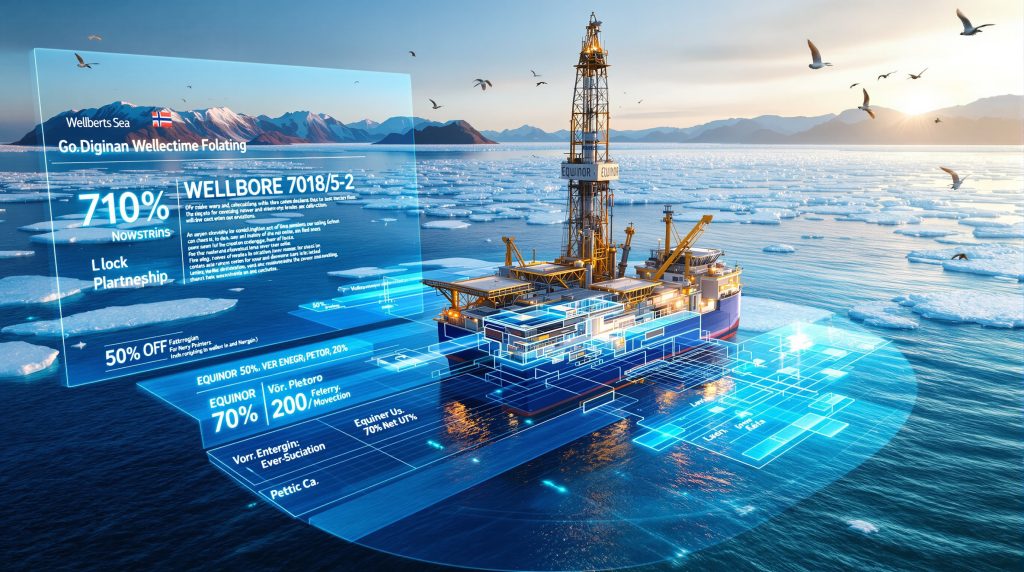Understanding Equinor's Strategic Arctic Exploration Initiative
The Norwegian Continental Shelf continues to attract significant exploration investment, with Equinor Energy AS recently securing approval for a critical Equinor Barents Sea exploration well that could reshape Norway's energy landscape. The Norwegian Offshore Directorate granted drilling permits for wellbore 7018/5-2 in production licence PL 1236, marking a significant milestone in Arctic hydrocarbon development.
This exploration initiative represents more than routine drilling operations. The wellbore's strategic positioning near existing Barents Sea infrastructure creates opportunities for accelerated development timelines and reduced capital expenditure requirements, distinguishing it from isolated frontier prospects that often face decades-long development cycles.
Production Licence 1236's Partnership Structure and Strategic Positioning
The drilling campaign operates under a carefully structured partnership model that leverages complementary expertise and risk distribution across three Norwegian energy entities:
| Partner | Ownership Percentage | Primary Role |
|---|---|---|
| Equinor Energy AS | 50% | Operator and technical lead |
| Vår Energi | 30% | Development partner |
| Petoro | 20% | State interest holder |
This partnership structure reflects Norway's strategic approach to Arctic exploration, combining private sector technical capabilities with state oversight through Petoro's participation. The 50% operator stake provides Equinor with decision-making authority while distributing geological and financial risks across established Norwegian energy companies.
Regional Infrastructure Connectivity Advantages
The wellbore's proximity to existing Barents Sea infrastructure creates substantial operational advantages compared to isolated frontier exploration targets. This strategic positioning enables:
- Reduced tie-in distances to established pipeline networks
- Lower development costs through shared infrastructure utilisation
- Accelerated production timelines following potential discoveries
- Enhanced operational safety through proximity to support facilities
These infrastructure advantages significantly improve the project's economic viability threshold, potentially making smaller discoveries commercially feasible compared to remote Arctic prospects requiring standalone development solutions.
Regulatory Framework and APA 2023 Context
The Norwegian Offshore Directorate's approval under Section 13 of the Resource Management Regulations represents a streamlined authorisation process specifically designed for established hydrocarbon provinces. This regulatory framework acknowledges the Barents Sea's proven geological potential while maintaining rigorous environmental and safety standards.
Furthermore, this approval process reflects the industry's evolving approach to managing deep‐sea mining concerns while maintaining exploration momentum. Consequently, the framework demonstrates Norway's commitment to balancing resource development with environmental stewardship.
The Awards in Predefined Areas initiative demonstrates Norway's commitment to maintaining exploration activity in mature basins while balancing environmental considerations with energy security objectives.
APA 2023 Licensing Round Significance
Production licence 1236 emerged from the 2023 APA licensing round, which focused specifically on southern Barents Sea acreage. This licensing strategy reflects several key policy objectives:
- Maintaining exploration momentum in proven hydrocarbon provinces
- Supporting regional economic development in northern Norway
- Enhancing domestic energy security through reserve replacement
- Leveraging existing infrastructure to improve project economics
The southern Barents Sea designation provides enhanced exploration incentives while implementing streamlined environmental assessment protocols tailored to areas with established industrial activity.
Technical Specifications and Operational Parameters
Well 7018/5-2 represents frontier exploration targeting in a geologically complex but potentially rewarding Arctic environment. The technical specifications highlight the sophisticated approach required for successful Barents Sea operations:
| Parameter | Specification |
|---|---|
| Well designation | 7018/5-2 |
| Licence block | PL 1236 |
| Regional setting | Southern Barents Sea |
| Prospect classification | Frontier exploration |
| Infrastructure access | High proximity rating |
| Expected spud date | Late 2025/Early 2026 |
Geological Target Assessment and Drilling Challenges
The Barents Sea presents unique geological characteristics that require specialised drilling technologies and operational expertise. In addition, successful drill results interpretation becomes crucial for understanding reservoir potential and optimising development strategies.
Key geological factors influencing the drilling campaign include:
- Complex structural geology with multiple fault systems
- Variable reservoir quality across different stratigraphic intervals
- Shallow gas hazards requiring enhanced well control procedures
- Permafrost considerations affecting wellbore stability
- Seasonal operational constraints limiting drilling windows
These geological complexities necessitate advanced drilling technologies, including sophisticated well control systems and real-time geological monitoring capabilities to ensure safe and efficient operations.
Arctic Energy Security and Strategic Importance
The exploration initiative supports Norway's comprehensive strategy to maintain reliable hydrocarbon production levels while managing the transition toward diversified energy portfolios. However, understanding energy transition strategies remains essential for balancing immediate energy needs with long-term sustainability goals.
Arctic exploration represents a critical component of long-term reserve replacement activities essential for sustaining Norway's position as a major energy exporter.
Domestic Gas Supply Reinforcement
European energy security considerations have elevated the strategic importance of Norwegian gas production, particularly following recent geopolitical developments affecting alternative supply sources. For instance, Equinor's exploration efforts in the Johan Castberg area have demonstrated the potential for significant hydrocarbon discoveries in this region.
The Barents Sea exploration programme contributes to:
- Long-term supply reliability for European gas markets
- Reserve base diversification across multiple Norwegian provinces
- Production plateau extension from mature southern North Sea fields
- Energy transition support through reliable baseload supply
Successful Barents Sea exploration results could significantly enhance Norway's position as a dependable energy supplier to European markets during a period of heightened energy security concerns.
Northern Norway Economic Development Impact
The exploration campaign generates substantial economic benefits for northern Norwegian communities through:
- Specialised maritime services supporting offshore operations
- Technical expertise centres developing Arctic drilling capabilities
- Logistics and supply chain operations based in regional ports
- Long-term employment opportunities in high-value technical sectors
These economic impacts extend beyond immediate drilling operations, creating sustainable industrial development opportunities in Arctic regions traditionally dependent on fishing and tourism industries.
Environmental Compliance and Sustainability Integration
Arctic drilling operations require enhanced environmental monitoring protocols and specialised technologies designed to minimise ecological impact while maintaining operational efficiency. Moreover, the sustainability transformation insights from other extractive industries provide valuable lessons for responsible Arctic development.
The regulatory framework governing Barents Sea exploration incorporates stringent environmental protection measures:
- Seasonal operational restrictions protecting marine ecosystem cycles
- Enhanced spill prevention and response capabilities
- Marine mammal monitoring during seismic and drilling operations
- Indigenous consultation requirements ensuring community engagement
- Real-time environmental monitoring throughout operational phases
Advanced Environmental Technologies
The drilling campaign incorporates cutting-edge environmental technologies specifically designed for Arctic conditions, including:
- Zero discharge drilling systems preventing formation water release
- Advanced blowout prevention equipment rated for Arctic conditions
- Real-time marine monitoring using autonomous underwater vehicles
- Biodegradable drilling fluids minimising long-term environmental impact
These technological approaches demonstrate the industry's commitment to responsible Arctic exploration while maintaining operational effectiveness in challenging environments.
Competitive Analysis and Regional Context
The PL 1236 exploration initiative operates within a broader context of Arctic hydrocarbon development across multiple Norwegian Continental Shelf regions. Furthermore, industry innovation trends continue to shape competitive positioning and technological advancement in Arctic exploration.
Comparative analysis reveals several distinguishing characteristics:
| Aspect | PL 1236 Campaign | Regional Benchmark |
|---|---|---|
| Partnership structure | Three-party consortium | Varied configurations |
| Infrastructure access | High proximity advantage | Mixed accessibility levels |
| Regulatory timeline | Streamlined approval | Standard permitting process |
| Operational window | Late 2025/Early 2026 | Variable seasonal timing |
| Risk profile | Moderate frontier risk | Diverse risk categories |
Investment Strategy Implications
The exploration campaign represents Equinor's continued commitment to Arctic hydrocarbon development despite industry-wide portfolio shifts toward renewable energy investments. This strategic positioning reflects several key investment considerations:
- Long-term hydrocarbon demand scenarios supporting continued exploration
- Portfolio diversification balancing renewable and conventional assets
- Technical expertise maintenance in challenging Arctic environments
- Strategic option value creation through acreage position building
Success Scenarios and Value Creation Opportunities
The Equinor Barents Sea exploration well presents multiple potential outcomes with varying implications for stakeholder value creation and regional energy development. Consequently, regulatory approvals for Barents Sea exploration demonstrate the government's continued support for Arctic development initiatives.
Discovery Scenario Planning Framework
- Commercial discovery confirmation through comprehensive well testing
- Resource volume estimation using advanced reservoir modelling techniques
- Development feasibility assessment incorporating infrastructure integration costs
- Environmental impact evaluation determining acceptable development parameters
- Market timing optimisation aligning with European gas demand cycles
Each scenario requires different technical approaches and investment commitments, with successful outcomes potentially triggering accelerated regional exploration programmes across adjacent Barents Sea acreage.
Strategic Value Enhancement Opportunities
Beyond immediate exploration results, the drilling campaign creates several strategic value enhancement opportunities:
- Technical knowledge accumulation improving future Arctic drilling efficiency
- Infrastructure utilisation optimisation reducing regional development costs
- Partnership model validation for complex Arctic exploration projects
- Regulatory process refinement streamlining future permitting procedures
Norway's Energy Transition Balance and Dual-Track Strategy
The Barents Sea exploration initiative exemplifies Norway's sophisticated approach to managing energy transition challenges while maintaining economic competitiveness and energy security capabilities. This dual-track strategy simultaneously pursues:
Hydrocarbon Portfolio Maintenance
- Reserve base replacement ensuring long-term production sustainability
- Infrastructure asset optimisation maximising existing facility utilisation
- Technical capability preservation maintaining Arctic exploration expertise
- Economic transition support providing revenue streams funding renewable investments
Renewable Energy Integration
The exploration programme operates alongside Norway's substantial renewable energy investments, creating a balanced portfolio approach that manages transition risks while capitalising on immediate market opportunities.
The integration of traditional hydrocarbon exploration with renewable energy development demonstrates Norway's pragmatic approach to energy transition, recognising the need for reliable energy supplies during the decades-long transformation process.
Future Implications and Industry Significance
The approval of well 7018/5-2 drilling operations extends far beyond a single exploration initiative, establishing precedents for efficient Arctic exploration methodologies and regulatory frameworks. The project's outcomes will likely influence:
- Future Arctic exploration policies across the Norwegian Continental Shelf
- International Arctic development standards through Norwegian technical leadership
- Partnership model adoption for complex frontier exploration projects
- Environmental technology advancement in Arctic drilling applications
The campaign serves as a significant test case for balancing aggressive exploration targets with stringent environmental protection requirements, potentially establishing new industry standards for responsible Arctic resource development. However, the Equinor Barents Sea exploration well also represents a critical milestone in Norway's ongoing efforts to maintain its position as a leading energy supplier whilst adapting to evolving global energy demands.
Disclaimer: This article contains analysis and speculation regarding future energy market developments and exploration outcomes. Actual results may vary significantly from projections discussed. Investment decisions should be based on comprehensive due diligence and professional financial advice.
Ready to Invest in the Next Major Energy Discovery?
Discovery Alert instantly alerts investors to significant ASX mineral discoveries using its proprietary Discovery IQ model, turning complex exploration data into actionable insights. Begin your 30-day free trial today at https://discoveryalert.com.au/ and position yourself ahead of the market when the next transformative discovery is announced.




